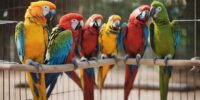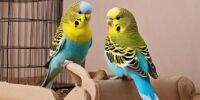How to Recognize the Various Species of Lovebirds
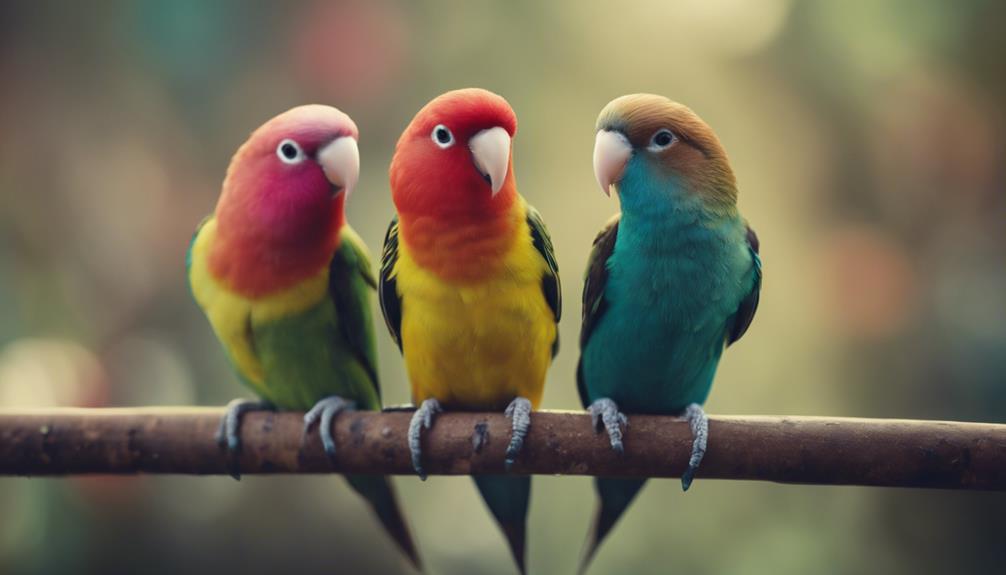
Learn to identify lovebird species by observing their unique physical characteristics and behaviors.
Deepen your connection with these colorful birds and contribute to their conservation efforts.
Key Takeaways
- Peach-Faced Lovebirds have distinctive rosy cheeks.
- Nyasa Lovebirds are smaller with green feathers and pink faces.
- Black-Cheeked Lovebirds are endangered with a unique yellow collar.
- Black-Masked Lovebirds have a bright red beak and yellow collar.
Peach-Faced Lovebird Identification
Peach-Faced Lovebirds can be easily identified by their distinctive rosy or orange-colored cheeks, a hallmark of this vibrant and colorful species. These small-sized lovebirds, typically measuring 7-8 inches and weighing under 2 ounces, are native to Africa but can also be spotted in flocks in Arizona. Known scientifically as Agapornis roseicollis, Peach-Faced Lovebirds are a popular choice as pets due to their social nature and playful demeanor.
Their rosy cheeks set them apart from other lovebird species, adding to their allure as beloved companions. The striking coloration on their cheeks contrasts beautifully with their overall plumage, creating a visually appealing bird that captivates many enthusiasts. In addition to their physical characteristics, Peach-Faced Lovebirds' engaging personalities and strong social bonds make them highly sought after in the world of aviculture.
Whether in the wild or as pets, these lovebirds bring joy and vibrancy wherever they go.
Nyasa or Lilian Lovebird Recognition
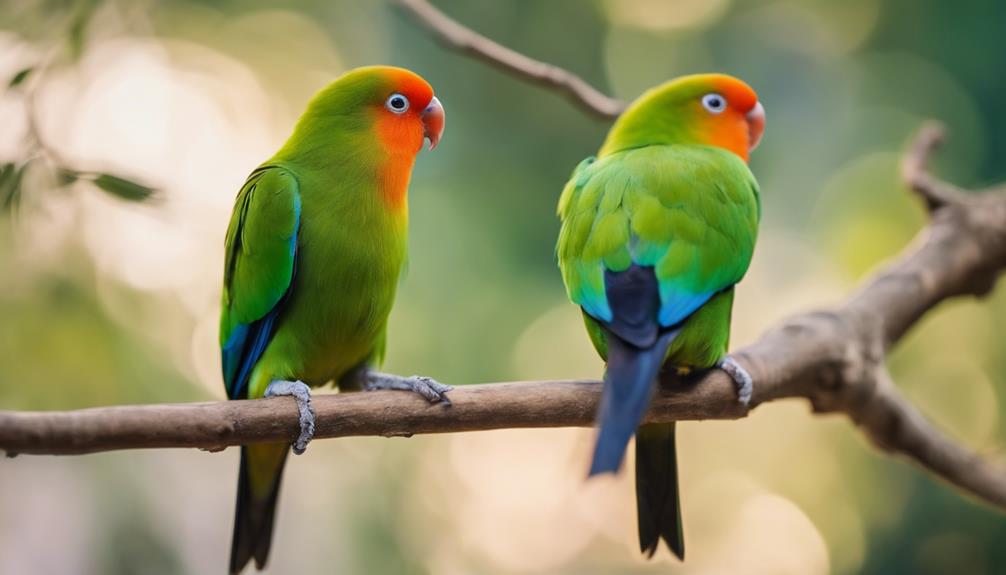
Distinguishing Nyasa or Lilian Lovebirds can be achieved by noting their distinctive green feathers and salmon-pink face, setting them apart from other species in the lovebird family. These lovebirds, scientifically known as Agapornis lilianae, are native to Zimbabwe, Zambia, Tanzania, and Malawi.
They're characterized by their smaller size compared to other lovebird species, with an average length of 5.4 inches and a weight ranging from 1 to 1.3 ounces. Due to breeding challenges, Nyasa Lovebirds are rare in captivity, making them highly desirable for experienced bird keepers seeking unique avian companions.
Their striking appearance and limited availability add to their allure, emphasizing the importance of conservation efforts to ensure the continued existence of these enchanting birds in the wild.
Madagascar or Grey-Headed Lovebird Traits
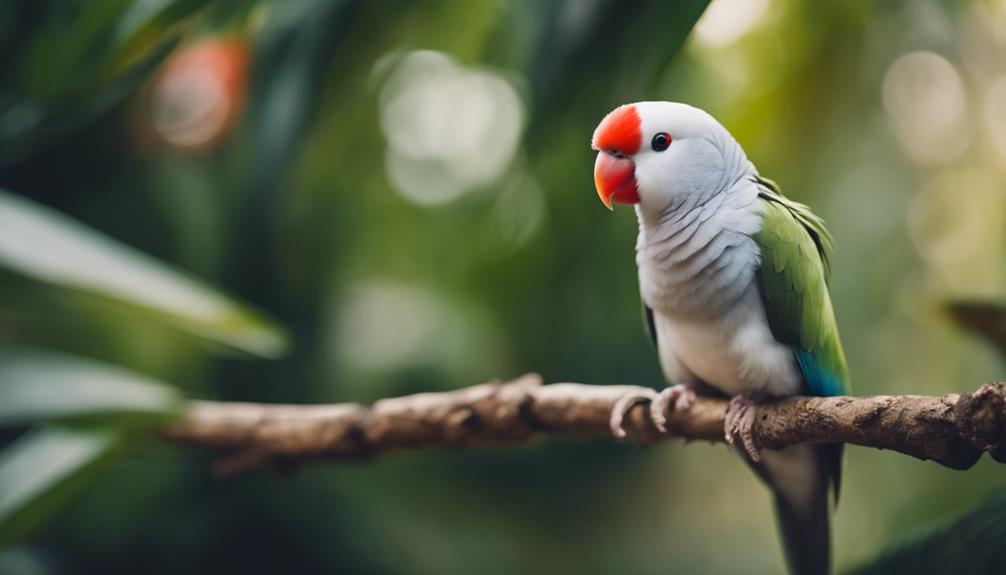
Grey-headed lovebirds, the smallest species of lovebirds, exhibit distinctive traits including light gray heads and chests in males and a vibrant green coloration in females, making them a unique and intriguing species native to Madagascar.
These Madagascar lovebirds are entirely green, with males showcasing a beautiful contrast of gray on their heads and chests. Due to their delicate nature, they're rarely seen in captivity, as they've specific habitat requirements that need to be met to thrive.
Being native to Madagascar, these birds are easily scared, emphasizing the need for specialized care when handling them. Grey-headed lovebirds aren't commonly kept as pets, and their specialized needs make them more suitable for experienced bird keepers who understand the intricacies of their behavior and environment.
For those who appreciate the challenge of caring for these rare and captivating creatures, the grey-headed lovebird proves to be a rewarding species to observe in its natural habitat.
Black-Cheeked Lovebird Characteristics
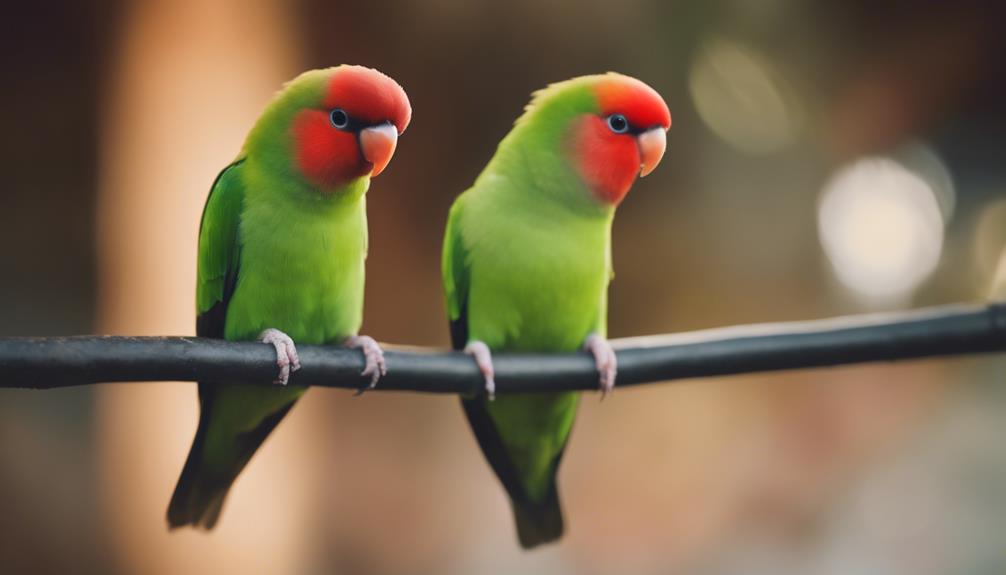
The Black-Cheeked Lovebird, an endangered species native to Southwest Zambia, is recognized for its predominantly green plumage with striking black faces. These charming birds are often involved in breeding programs as part of conservation efforts to protect their vulnerable species status attributed to habitat loss.
Despite their endangered status, Black-Cheeked Lovebirds are known for their gentle and docile nature, making them beloved among bird enthusiasts. Here are some key characteristics of the Black-Cheeked Lovebird:
- Distinctive Appearance: Their green feathers and black faces make them easily distinguishable from other lovebird species.
- Endangered Status: Due to habitat loss in Southwest Zambia, these birds are critically endangered in the wild.
- Conservation Efforts: Many breeding programs focus on the Black-Cheeked Lovebird to ensure the survival of the species.
- Docile Nature: Despite their endangered status, Black-Cheeked Lovebirds are known for their friendly and gentle temperament, endearing them to those who encounter them.
Black-Masked or Yellow-Collared Lovebird Features
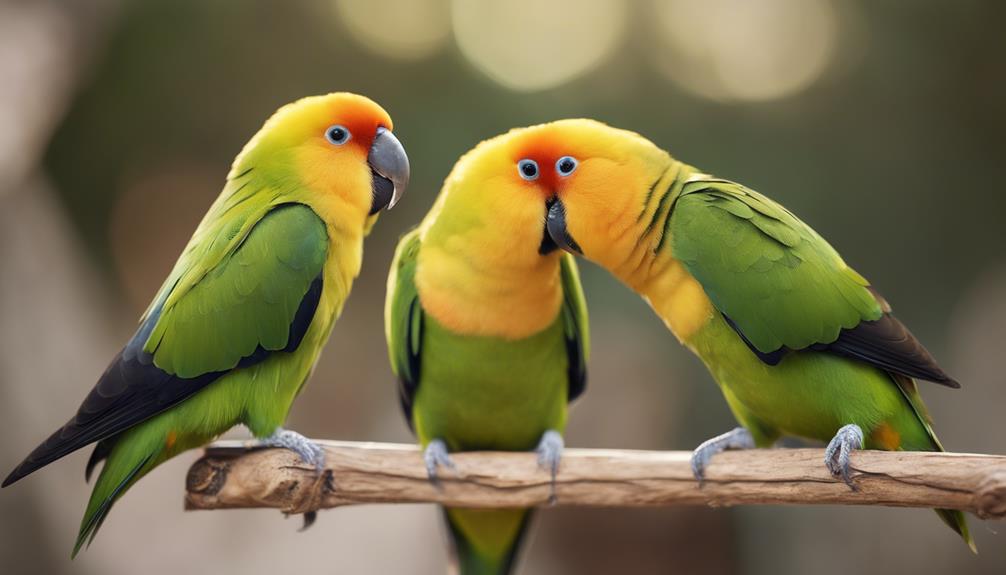
Black-Cheeked Lovebirds share similarities with Black-Masked or Yellow-Collared Lovebirds in their distinct facial markings and vibrant plumage colors, yet the latter species is easily distinguished by its bright red beak and unique yellow collar.
Found in Northeast Tanzania, these lovebirds, scientifically known as Agapornis personata, exhibit a less aggressive behavior compared to peach-faced lovebirds. Measuring an average of 5.5 inches in size and weighing around 1.7 ounces, they showcase unique coloration and markings that make them stand out.
The striking red beak and the contrasting yellow collar are key features that set them apart from other lovebird species. Their elegant appearance and docile nature make them a favorite among bird enthusiasts. When observing these charming birds, their distinctive traits, including the red beak and yellow collar, serve as clear identifiers of the beautiful Black-Masked or Yellow-Collared Lovebirds.
Black-Collared or Swinderns Lovebird Identification
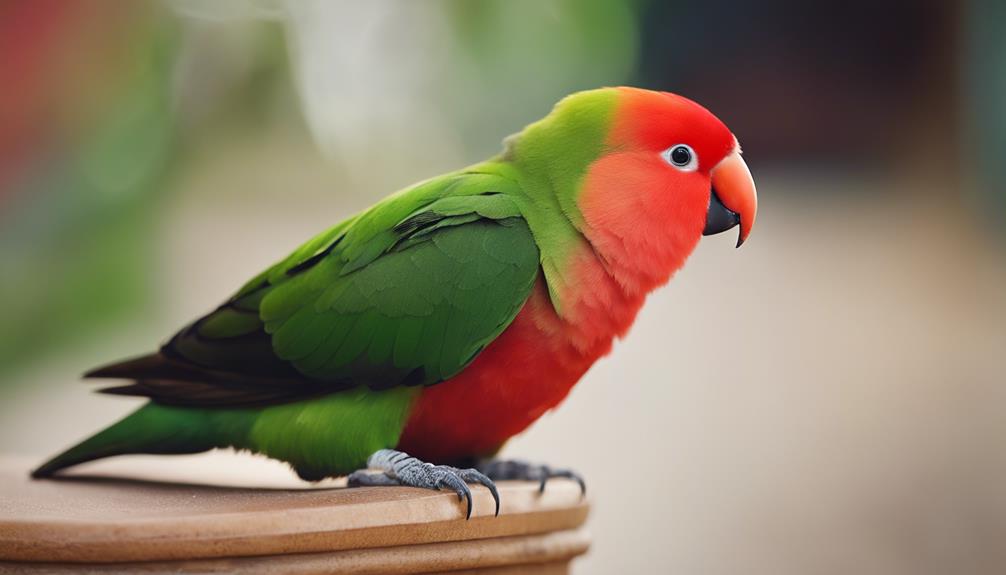
With a distinct black half collar at the back of its neck, the Black-Collared or Swinderns Lovebird (Agapornis swindernianus) can be identified by its predominantly green plumage. These small birds, measuring around 13-13.5 cm in length, aren't commonly kept as pets due to their specific dietary requirements. Breeding Black-Collared Lovebirds in captivity is challenging, resulting in them being less prevalent in the pet trade.
- Distinctive Marking: The black half collar on the back of the neck sets the Black-Collared Lovebird apart.
- Size: Despite their small size, these birds have a striking appearance.
- Dietary Needs: Their specific dietary requirements make them a challenging species to care for in captivity.
- Popularity: Due to the difficulties in breeding and caring for them, Black-Collared Lovebirds are less common in the pet trade compared to other species.
Black-Winged or Abyssinian Lovebird Identification
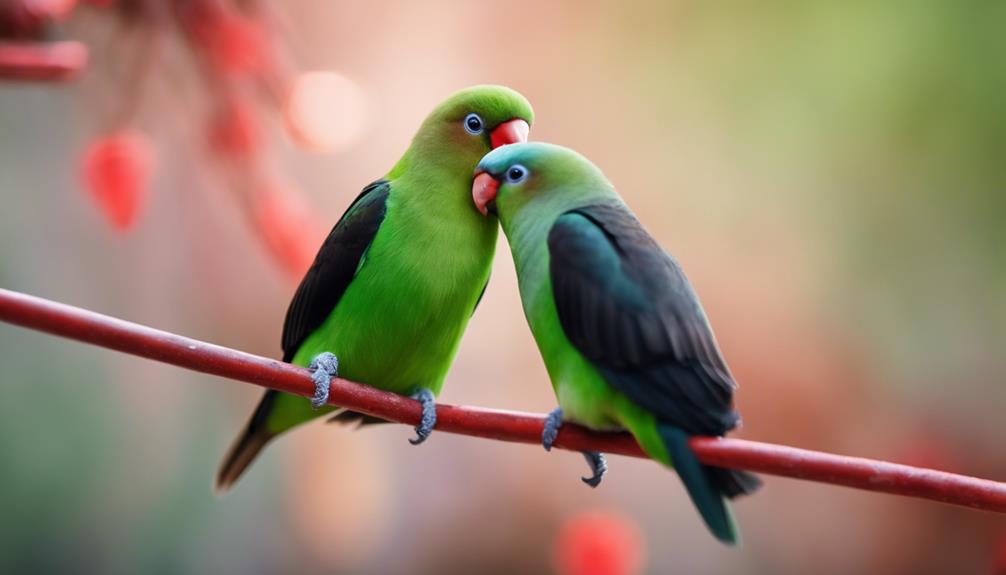
Black-Winged Lovebirds, also known as Abyssinian Lovebirds, exhibit unique traits that set them apart from other lovebird species. Understanding the specific characteristics and physical differences of Abyssinian Lovebirds is crucial for accurate identification.
Observing features such as size, plumage coloration, and markings can aid in distinguishing these lovebirds from their counterparts.
Black-Winged Lovebird Traits
Larger in size compared to other lovebird species, measuring between 15-17 cm in length, the Abyssinian lovebirds, also known as black-winged lovebirds, exhibit distinct physical characteristics that make them easily recognizable.
Male and female black-winged lovebirds have visible differences in appearance, aiding in sex identification.
Black-winged lovebirds are less noisy than other species, suitable for those seeking quieter pets.
Breeding black-winged lovebirds is more challenging, leading to their lesser popularity as pets.
These active and playful birds require a variety of toys and mental stimulation for optimal health and well-being.
Abyssinian Lovebird Characteristics
Abyssinian Lovebirds, distinguished by their bright green plumage with a red forehead in males and duller green appearance in females, are small parrots originating from the Abyssinian highlands in Africa. These dark green, short-tailed lovebirds are found in savannas, woodlands, and forests, displaying a distinct appearance that sets them apart from other lovebird species.
Known for their unique combination of dark green bodies and red foreheads, Abyssinian Lovebirds are both expensive to acquire and challenging to breed compared to their counterparts. Their scarcity adds to their allure, making them a coveted choice for avian enthusiasts seeking a special touch of elegance and rarity in their collections.
Physical Differences to Note
Easily recognizable by their distinctive bright green plumage and red foreheads in males, Abyssinian lovebirds are small parrots known for their unique appearance. Here are some physical differences to note between the male and female Abyssinian lovebirds:
- Plumage: Males display bright green plumage with striking red foreheads, while females have duller green coloring without the red markings.
- Size: Both males and females are small, short-tailed parrots, with the males typically exhibiting more vibrant colors.
- Coloration: Abyssinian lovebirds are mostly dark green in color, with males standing out due to their red foreheads.
- Identification: The visual distinctions between male and female Abyssinian lovebirds make them easily identifiable, although they're more expensive and challenging to breed compared to other lovebird species.
Frequently Asked Questions
How Do I Identify My Lovebird?
To identify a lovebird, notice its colorful plumage, unique markings, distinctive calls, and behavior patterns. Look at physical characteristics like wing span, tail feathers, facial features, and eye color. Consider personality traits for a complete understanding.
What Are the Different Types of Lovebirds?
Lovebirds come in various species, each with distinct traits. From the common Peach-Faced to the rare Nyasa, their colors range from rosy to green. While some are aggressive, others have milder personalities. Care involves diet, nesting, and breeding.
What Is the Rarest Type of Lovebird?
The rarest type of lovebird is the Black-Cheeked Lovebird, known for its unique black faces and orange chest patches. Endangered and mostly found in breeding programs, these lovebirds are focused on conservation efforts to preserve their dwindling population.
What Is the Least Aggressive Lovebird?
Black-Masked Lovebirds are peaceful companions with friendly interactions and gentle, playful antics. Known for their calm demeanor and mellow temperament, they exhibit non-aggressive behavior. These easy-going birds make sociable pets with docile personalities.



